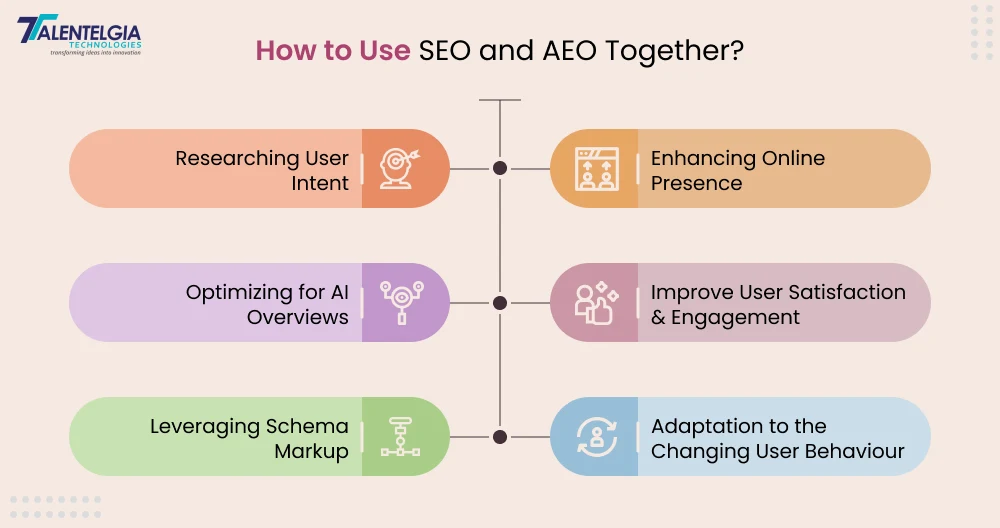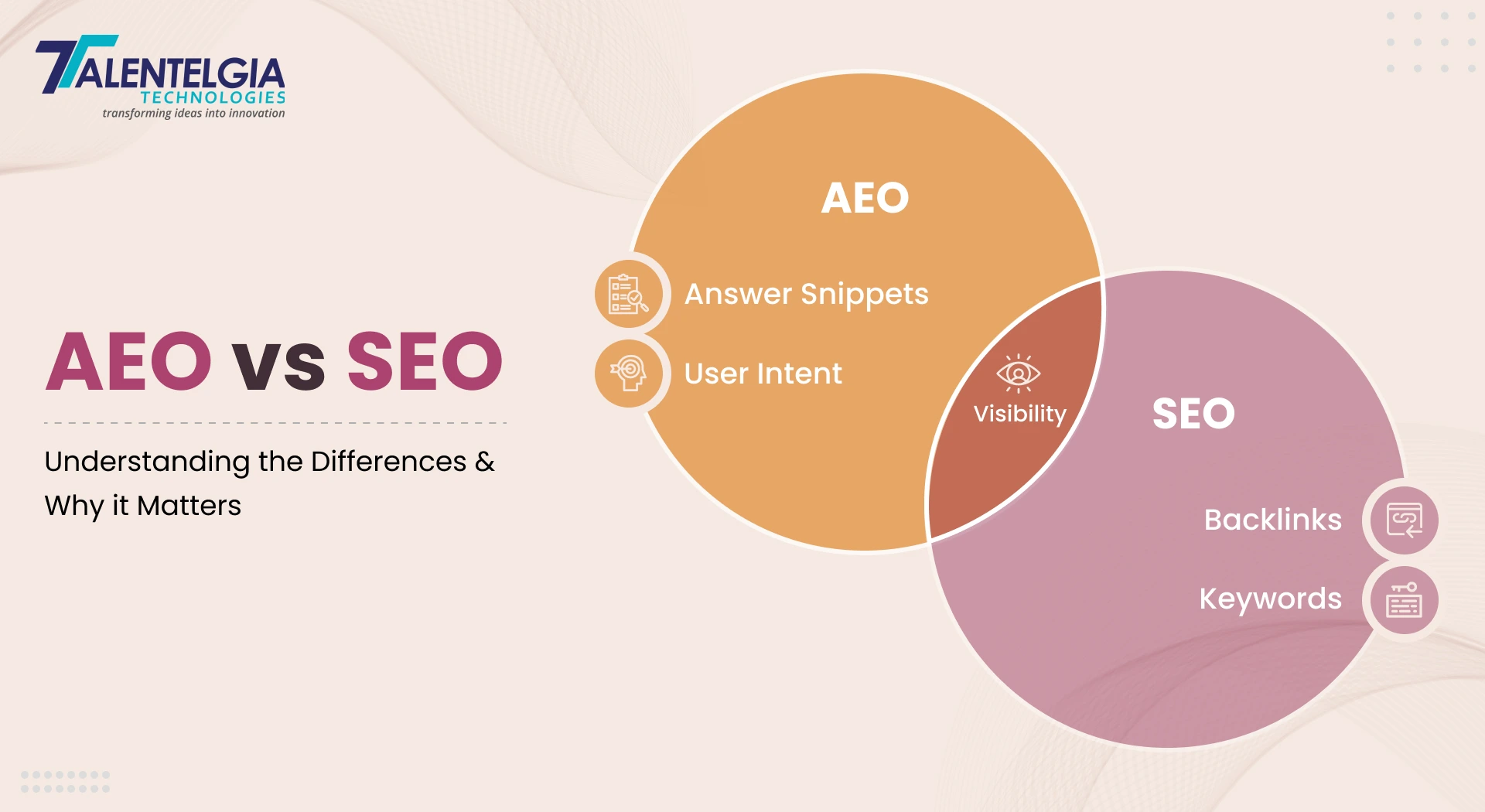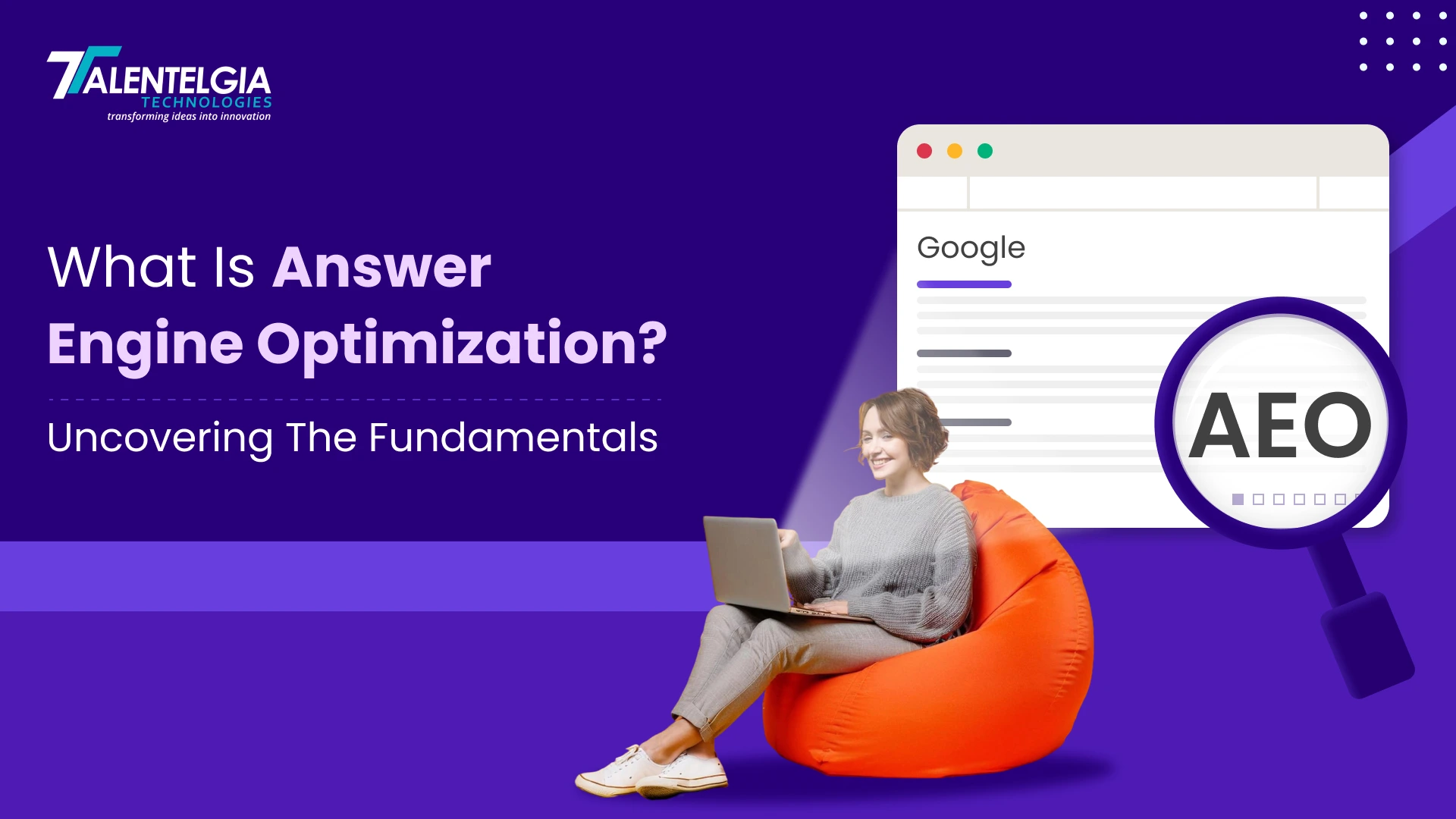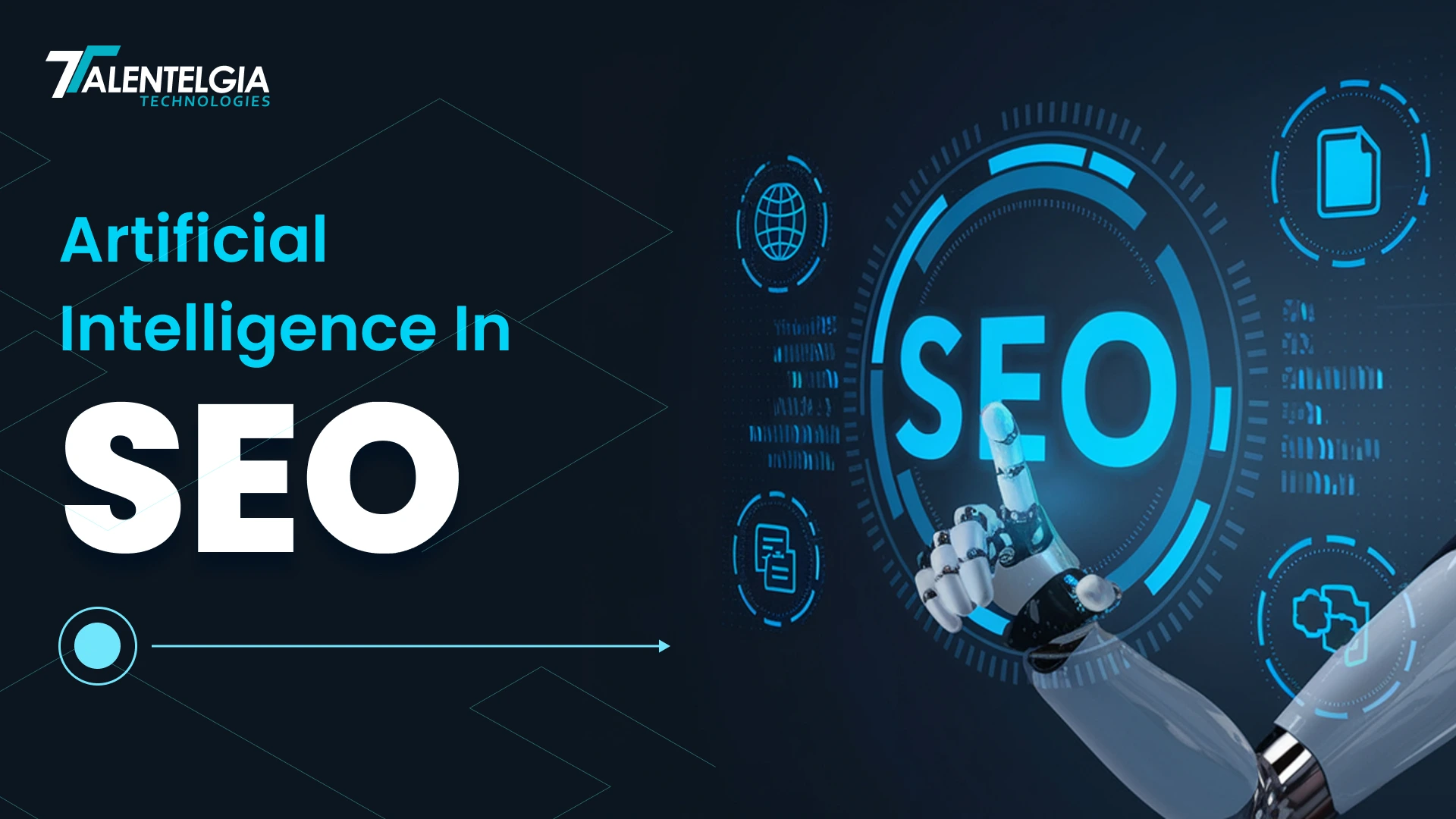Do you know?
AI Overviews appear 47% of Google searches and take up nearly half the screen space on both desktop and mobile devices.
Ranking on Google used to be the ultimate goal. But today, AI-driven search tools are delivering instant answers—often without users clicking through to a website.
This shift has made Answer Engine Optimization (AEO) just as important as traditional SEO.
So, if you are a business exploring the right strategy for your business, read below to learn more about these technological terms and better understand AEO vs. SEO.
What is SEO?
Search engine optimization is the process of changing a website to make it more visible on search engines such as Google, Bing, and Yahoo. It seeks to generate organic traffic by matching web content with user intent and search engine algorithms.
Key Components of SEO
Keyword Research
Keywords are the most basic part of SEO, identifying the keywords that users search for. This also includes targeting primary and long-tail keywords based on search volume vs. competition.
On-Page Optimization
This includes SEO best practices like ensuring title tags, meta descriptions, headers, and content structure are optimized. These help search engines understand the topic of a page and rank them for the most relevant searches.
Domain Authority and Backlinks
Quality backlinks from credible sites enhance domain authority and credibility. This leads to better Google rankings.
Technical SEO
Factors like good page speed, mobile responsiveness, structured data, and good HTTPS – also affect the SEO scores.
What is AEO?
Answer Engine Optimization (AEO) optimizes the content to make it easy to retrieve from AI-enabled search engines and voice assistants. So, whereas SEO is about getting web pages to rank, AEO is about presenting content to deliver fast, accurate, and authoritative responses to their searchers.
Key Components of AEO
Optimizing for Voice Search and AI Assistants
AEO ensures content is conversational and answers common queries concisely, making it accessible for voice search users.
Structured Data and Schema Markup
Schema markup helps search engines comprehend the content context. This increases the chances of being featured in snippets and AI-generated replies.
Concise and Direct Content Creation
AEO prefers direct, clear, and well-structured answers, typically formatted into FAQs, bullet points, and short paragraphs for better visibility.
AEO vs SEO – Key Differences
| Factor | SEO | AEO |
|---|---|---|
| Primary Goal | Improve website rankings on SERPs | Provide direct answers via AI-driven search engines |
| Content-Type | Long-form, keyword-focused content | Short, structured, and intent-driven content |
| Optimization Focus | Web pages and link-building | Schema markup and featured snippets |
| Search Intent | Users searching for information | Users asking direct questions |
| Primary Platforms | Google, Bing, Yahoo | Voice search (Google Assistant, Siri, Alexa) and AI-generated answers |
The Growing Importance of AEO
Search engines are changing, and so are the ways users interact with content information. Classic search engine optimization (SEO) has been a go-to for online visibility. But now AI-powered search agents and zero-click results are leading to Answer Engine Optimization (AEO). While SEO is about securing the top-ranking spots in search results, AEO is about AI search engine results.
Further, as more users turn to voice search, featured snippets, and AI-generated responses, businesses that don’t optimize for AEO risk losing their place in line—even if they rank high traditionally. Therefore brands need to adapt their content strategies while balancing AEO vs SEO to remain relevant. Therefore the information needs to be comprehensible, structured, and accurate for search engine consumption. Here are some of the latest trends in AEO:
AI and Voice Search
AI-powered search engines are changing how users search for information by offering direct conversational answers rather than more traditional search listings. The increasing use of voice search is powered by virtual assistants such as Google Assistant, Siri, and Alexa. Therefore, this means businesses must optimize for spoken queries rather than just typed searches. Further, as users now ask detailed, conversational questions, AEO makes the content simpler for AI systems to decipher and present.
Zero Click Searches
Today, users are presented with immediate answers via featured snippets, knowledge panels, or AI-generated responses. So, more than half of Google searches do not lead users to visit a website. This is why getting on page one isn’t enough anymore. Businesses must now also compete for zero-click searches – where AI draws in relevant content to deliver instant answers. AEO keeps the brand present and positioned even if users decide not to click through to a website. This explains why localized, succinct, and contextual content is so important.
Enhanced User Experience with Immediate Answers
Modern-day users demand precise and simple information. AEO prioritizes instant answers that address users’ questions at greater frequency. AEO reduces friction in the user journey, enhancing engagement, which helps brands build trust and credibility with their audience. Consumers are less likely to leave a site if it streamlines the content to provide immediate answers without the user having to explore unnecessary layers of navigation.
Challenges of Answer Engine Optimization (AEO)
While AEO offers new opportunities for visibility, it also presents unique challenges. From adapting content for AI-driven searches to competing for limited answer space, businesses must rethink their strategies to stay ahead when it comes to SEO vs AEO.
Increased Competition
And with more businesses optimizing for AI-generated results, it is increasingly difficult to rank in zero-click searches.
Algorithm Changes
Search engines based on AI are continuously being improved, which means that firms must regularly change their strategies.
Resource Intensity
Integrating structured data, voice search optimization and formatting content for AI takes a lot of time and knowledge.
How Do SEO and AEO Work Together?
52% of sources mentioned by Google AI overviews rank in the top 10 results.
So, the shift to this new AI-driven search requires businesses to adapt their strategies rather than overlook the “old” SEO. Unlike AEO, it ensures long-form content builds authority and rankings. The trick is finding a middle ground — a balance between AEO vs SEO to appeal to the AI interpretation while ensuring organic search visibility. Here’s how businesses can incorporate AEO into their SEO strategy successfully.

Enhancing Online Presence
Holistic SEO and AEO bring a brand’s presence beyond search into the rest of cyberspace. Traditional SEO works towards securing rankings on search engine result pages, and AEO helps with discoverability in AI-generated responses, featured snippets, and voice searches. By utilizing both approaches, companies can get a competitive advantage by reaching users who depend on traditional search engines and AI-driven assistants.
Improve User Satisfaction and Engagement
Optimizing content for AEO and SEO to deliver users relevant, instant, and accurate responses. AEO ensures that users find instant answers to their questions while seeking content that further builds context around a topic. This works well for retaining visitors to the site and saves you from the AEO vs SEO predicament!
Adaptation to the Changing User Behaviour
Search trends are changing rapidly, moving more into AI-powered search assistants, voice search, and instantaneous answers. Companies that stick to traditional strategies risk losing visibility as AEO takes over the search landscape. Yet, abolishing SEO entirely is damaging too. The future of search and content creation is a combination of SEO best practices and an AEO-focused content structure. This makes sure businesses are not only preparing for the future of search but also future-proofing their digital marketing efforts. Therefore by achieving this, your content marketing model would be adaptable to changes in search algorithms and customer behaviors.
Researching User Intent
Businesses must understand how users ask questions (via voice search or typed query) to balance SEO and AEO. Rather than only focusing on keyword density, analyze search intent. You should know whether customers are looking for a quick answer, a thorough explanation, or step-by-step instruction. Creating content for direct answers (for AI) as well as in-depth information (for SEO) is essential for visibility across all types of search formats.
Optimizing for AI Overviews
Google’s search overviews are driven by AI output summaries of responses from various sources. For these results to show up, businesses need to structure their content so that AI can easily pull and compile information. Concise subheadings, bulleted lists, and clear answers to the questions balance AI-generated content summaries and traditional search-based rankings.
Leveraging Schema Markup
Schema markup is a key part of AEO to simplify the content for search engines. Insert structured data, including FAQ schema, How-To schema, and Article schema. This ensures the chances for content to show up in rich snippets and AI-generated responses or voice search results. Structured data adoption ensures AI systems have an easier time understanding and classifying content. This enhances the likelihood that it will be indexed and surfaced in zero-click queries.
Conclusion
SEO is an integral part of digital marketing that improves ranking and ultimately the traffic for the website. However, with the rise of AI-powered search engines and voice assistants, AEO is also becoming important.
To manage the new landscape of SEO vs AEO, businesses need to create a content strategy to optimize for both traditional rankings and AI-generated responses.
Shifting towards a holistic strategy will help companies maximize visibility, drive engagement, and keep pace with a changing search type.


 Healthcare App Development Services
Healthcare App Development Services
 Real Estate Web Development Services
Real Estate Web Development Services
 E-Commerce App Development Services
E-Commerce App Development Services E-Commerce Web Development Services
E-Commerce Web Development Services Blockchain E-commerce Development Company
Blockchain E-commerce Development Company
 Fintech App Development Services
Fintech App Development Services Fintech Web Development
Fintech Web Development Blockchain Fintech Development Company
Blockchain Fintech Development Company
 E-Learning App Development Services
E-Learning App Development Services
 Restaurant App Development Company
Restaurant App Development Company
 Mobile Game Development Company
Mobile Game Development Company
 Travel App Development Company
Travel App Development Company
 Automotive Web Design
Automotive Web Design
 AI Traffic Management System
AI Traffic Management System
 AI Inventory Management Software
AI Inventory Management Software
 AI Software Development
AI Software Development  AI Development Company
AI Development Company  AI App Development Services
AI App Development Services  ChatGPT integration services
ChatGPT integration services  AI Integration Services
AI Integration Services  Generative AI Development Services
Generative AI Development Services  Natural Language Processing Company
Natural Language Processing Company Machine Learning Development
Machine Learning Development  Machine learning consulting services
Machine learning consulting services  Blockchain Development
Blockchain Development  Blockchain Software Development
Blockchain Software Development  Smart Contract Development Company
Smart Contract Development Company  NFT Marketplace Development Services
NFT Marketplace Development Services  Asset Tokenization Company
Asset Tokenization Company DeFi Wallet Development Company
DeFi Wallet Development Company Mobile App Development
Mobile App Development  IOS App Development
IOS App Development  Android App Development
Android App Development  Cross-Platform App Development
Cross-Platform App Development  Augmented Reality (AR) App Development
Augmented Reality (AR) App Development  Virtual Reality (VR) App Development
Virtual Reality (VR) App Development  Web App Development
Web App Development  SaaS App Development
SaaS App Development Flutter
Flutter  React Native
React Native  Swift (IOS)
Swift (IOS)  Kotlin (Android)
Kotlin (Android)  Mean Stack Development
Mean Stack Development  AngularJS Development
AngularJS Development  MongoDB Development
MongoDB Development  Nodejs Development
Nodejs Development  Database Development
Database Development Ruby on Rails Development
Ruby on Rails Development Expressjs Development
Expressjs Development  Full Stack Development
Full Stack Development  Web Development Services
Web Development Services  Laravel Development
Laravel Development  LAMP Development
LAMP Development  Custom PHP Development
Custom PHP Development  .Net Development
.Net Development  User Experience Design Services
User Experience Design Services  User Interface Design Services
User Interface Design Services  Automated Testing
Automated Testing  Manual Testing
Manual Testing  Digital Marketing Services
Digital Marketing Services 
 Ride-Sharing And Taxi Services
Ride-Sharing And Taxi Services Food Delivery Services
Food Delivery Services Grocery Delivery Services
Grocery Delivery Services Transportation And Logistics
Transportation And Logistics Car Wash App
Car Wash App Home Services App
Home Services App ERP Development Services
ERP Development Services CMS Development Services
CMS Development Services LMS Development
LMS Development CRM Development
CRM Development DevOps Development Services
DevOps Development Services AI Business Solutions
AI Business Solutions AI Cloud Solutions
AI Cloud Solutions AI Chatbot Development
AI Chatbot Development API Development
API Development Blockchain Product Development
Blockchain Product Development Cryptocurrency Wallet Development
Cryptocurrency Wallet Development About Talentelgia
About Talentelgia  Our Team
Our Team  Our Culture
Our Culture 
 Healthcare App Development Services
Healthcare App Development Services Real Estate Web Development Services
Real Estate Web Development Services E-Commerce App Development Services
E-Commerce App Development Services E-Commerce Web Development Services
E-Commerce Web Development Services Blockchain E-commerce
Development Company
Blockchain E-commerce
Development Company Fintech App Development Services
Fintech App Development Services Finance Web Development
Finance Web Development Blockchain Fintech
Development Company
Blockchain Fintech
Development Company E-Learning App Development Services
E-Learning App Development Services Restaurant App Development Company
Restaurant App Development Company Mobile Game Development Company
Mobile Game Development Company Travel App Development Company
Travel App Development Company Automotive Web Design
Automotive Web Design AI Traffic Management System
AI Traffic Management System AI Inventory Management Software
AI Inventory Management Software AI Software Development
AI Software Development AI Development Company
AI Development Company ChatGPT integration services
ChatGPT integration services AI Integration Services
AI Integration Services Machine Learning Development
Machine Learning Development Machine learning consulting services
Machine learning consulting services Blockchain Development
Blockchain Development Blockchain Software Development
Blockchain Software Development Smart contract development company
Smart contract development company NFT marketplace development services
NFT marketplace development services IOS App Development
IOS App Development Android App Development
Android App Development Cross-Platform App Development
Cross-Platform App Development Augmented Reality (AR) App
Development
Augmented Reality (AR) App
Development Virtual Reality (VR) App Development
Virtual Reality (VR) App Development Web App Development
Web App Development Flutter
Flutter React
Native
React
Native Swift
(IOS)
Swift
(IOS) Kotlin (Android)
Kotlin (Android) MEAN Stack Development
MEAN Stack Development AngularJS Development
AngularJS Development MongoDB Development
MongoDB Development Nodejs Development
Nodejs Development Database development services
Database development services Ruby on Rails Development services
Ruby on Rails Development services Expressjs Development
Expressjs Development Full Stack Development
Full Stack Development Web Development Services
Web Development Services Laravel Development
Laravel Development LAMP
Development
LAMP
Development Custom PHP Development
Custom PHP Development User Experience Design Services
User Experience Design Services User Interface Design Services
User Interface Design Services Automated Testing
Automated Testing Manual
Testing
Manual
Testing About Talentelgia
About Talentelgia Our Team
Our Team Our Culture
Our Culture

















 Write us on:
Write us on:  Business queries:
Business queries:  HR:
HR: 




